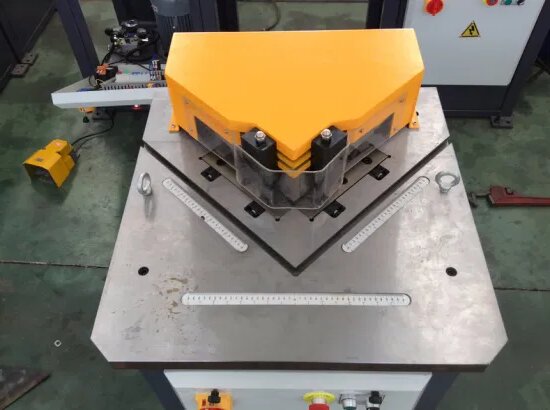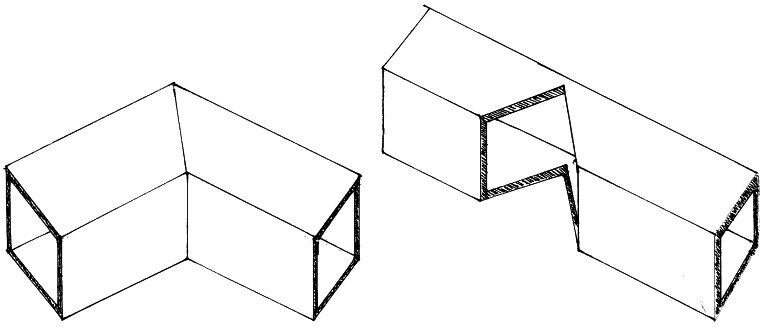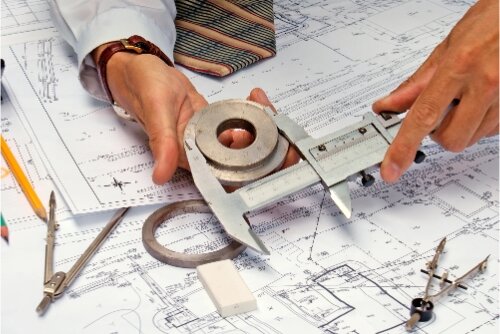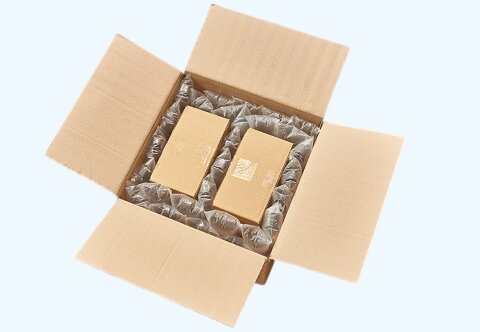제조 팀은 비용과 생산 시간을 줄이면서 정밀하고 내구성이 뛰어난 부품을 제공해야 한다는 끊임없는 압박에 직면합니다. 판금 노칭 오류는 자재 낭비, 프로젝트 지연, 품질 문제로 이어져 수익에 악영향을 미칩니다. 제조업체는 적절한 노칭 기술을 통해 불량률을 351%까지 줄이고 조립 시간을 401%까지 단축할 수 있습니다.
판금 노칭은 금속판에 정밀한 절단과 개구부를 생성하여 조립 중에 부품이 서로 매끄럽게 맞물릴 수 있도록 합니다. 최신 CNC 노칭 기계는 0.001인치 이내의 정확도를 달성하여 항공우주부터 소비자 가전까지 다양한 산업에서 복잡한 조립을 가능하게 합니다. 노칭 방법의 선택은 제품 품질과 제조 효율성에 직접적인 영향을 미칩니다.
다음 섹션에서는 제조의 우수성을 높이는 필수 노칭 기술, 재료 고려 사항 및 실제 적용 사례에 대해 살펴봅니다. 적절한 노칭이 엄격한 품질 표준을 유지하면서 생산성을 향상시키는 방법을 살펴봅니다.
판금 노칭이란 무엇인가요?
노칭은 일반적으로 모서리나 가장자리에서 특정 판금 섹션을 잘라내는 것을 말합니다. 이 프로세스를 통해 의도적인 틈을 만들어서 굽힘결합하거나 다른 구성 요소와 연동할 수 있습니다. 잘 실행된 노치는 응력 집중을 줄이고 구조적 무결성을 강화합니다.
제조 분야 노칭의 장점
금속 제조의 성공 여부는 생산 효율성, 품질 관리, 비용 관리에 달려 있습니다. 적절한 노칭 기술은 제조 작업에서 이러한 주요 성능 지표를 직접적으로 향상시킵니다.
효율성 향상
노칭을 통해 조립 공정 속도를 높이고 인건비를 절감할 수 있습니다:
- 50% 더 빠른 관절 준비
- 간소화 집회 시퀀스
- 보조 작업 감소
정확성과 일관성
최신 노칭 기술은 생산 과정 전반에 걸쳐 반복 가능한 결과를 제공합니다:
- 허용 오차 ±0.001인치 이내
- 균일한 조인트 간격
- 정확한 굴곡 허용치
- 일관된 부품 피팅
낭비 감소 및 비용 효율성 향상
전략적 노칭 관행을 통해 운영 비용을 절감할 수 있습니다:
- 25% 재료 낭비 감소
- 불량 부품 감소
- 재작업률 감소
금속 가공에서 노칭의 단점
제한 사항을 이해하면 프로세스 선택을 최적화하고 제조 문제를 방지하는 데 도움이 됩니다.
재료 응력 및 변형
물리적 제약은 자료 무결성에 영향을 미칩니다:
- 가장자리 경화
- 마이크로 크랙 위험
- 열 왜곡
- 작업 경화 효과
비용
초기 투자 및 운영 비용에는 다음이 포함됩니다:
- 장비 구매($5,000-$50,000)
- 유지 보수 요구 사항
- 운영자 교육
- 툴링 교체
두꺼운 소재의 한계
재료 두께는 프로세스 기능에 영향을 미칩니다:
- 최대 두께 제약 조건
- 전력 요구 사항
- 공구 마모율
- 처리 속도 감소

판금 노칭 공정은 어떻게 작동합니까?
판금 노칭 공정은 제어된 기계 작업을 통해 원자재를 정밀한 노칭 부품으로 변환합니다. 각 단계는 이전 단계를 기반으로 일관된 고품질의 결과를 보장합니다.
재료 준비
그리스, 오일 및 표면 오염 물질은 표적 세척 공정을 통해 제거됩니다. 기술자는 특수 도구를 사용하여 주요 기준점을 표시하고 미리 정해진 사양에 따라 재료를 배치합니다.
도구 선택 및 설정
작업자는 재료 특성 및 디자인 요구 사항에 따라 적절한 금형과 펀치를 선택합니다. 설정 절차에는 정렬 확인, 간격 조정, 샘플 소재에 대한 테스트 컷이 포함됩니다.
자르기 순서
작업자는 판금을 스톱 또는 고정 장치에 배치하여 올바른 방향을 유지합니다. 동력 시스템이 원활하게 맞물려 제어된 힘을 가하여 깨끗한 노치를 만듭니다.
품질 검증
품질 팀은 공정 관리를 위해 결과를 문서화하면서 적절한 적합성과 기능을 확인합니다. 신속한 피드백을 통해 생산 표준을 유지하기 위해 필요한 경우 즉시 조정할 수 있습니다.
판금 노칭 기술 및 방법
노칭 기법의 선택은 최종 제품 품질, 생산 속도 및 비용에 영향을 미칩니다. 각 방법은 특정 설계 요구 사항과 생산 시나리오에 따라 다릅니다.
직각 노칭
직각 노칭은 판금 모서리에 90도 절단을 생성합니다. 이 기술은 정사각형 조인트와 수직 굴곡이 필요한 응용 분야에 적합합니다. 이 공정은 일반적으로 한 면당 0.5~4인치 범위의 재료를 정밀하게 정사각형으로 제거합니다.
V-노칭
V 노칭은 복잡한 굴곡과 접합부에 각진 절단을 생성합니다. 이 공정은 30도에서 135도 사이의 각도로 V자형 노치를 만듭니다. 이러한 유연성 덕분에 재료 겹침 없이 다양한 굽힘 각도를 구현할 수 있습니다.
니블링 노칭
니블링은 미세하고 연속적인 컷을 사용하여 복잡한 노치 패턴을 만듭니다. 이 방법은 불규칙한 모양과 곡선에 유연성을 제공합니다. 한 번에 0.1~0.25인치의 재료가 한 스트로크당 제거됩니다.
가장자리 및 모서리 노치
가장자리 노칭은 조인트와 탭의 시트 가장자리를 수정합니다. 코너 노칭은 교차점에서 재료를 제거하여 굽힘 및 조립을 용이하게 합니다. 두 방법 모두 정밀한 깊이와 너비 제어가 필요합니다.
노칭 기법 비교
| 기술 | 속도 | 정도 | 비용 | 재료 범위(인치) |
|---|---|---|---|---|
| 직각 | 높은 | ±0.005" | Medium | 0.02-0.25 |
| V-노칭 | Medium | ±0.003" | 높은 | 0.01-0.19 |
| 니블링 | 낮은 | ±0.007" | 낮은 | 0.01-0.12 |
| 가장자리/코너 | 높은 | ±0.004" | Medium | 0.02-0.19 |
노칭에 사용되는 일반적인 재료
재료 선택은 노칭 파라미터, 공구 선택 및 최종 제품 품질에 영향을 미칩니다. 금속마다 특정 절삭 속도, 공구 형상 및 압력 설정이 필요합니다.
알류미늄
알루미늄은 부드러운 특성으로 인해 노칭 특성이 뛰어납니다. 가공 속도는 분당 200스트로크에 달하며 공구 마모가 최소화됩니다. 금속의 밀도가 낮고 성형성이 높아 복잡한 노칭 패턴에 이상적입니다.
일반적인 사양입니다:
- 두께 범위: 0.020″ - 0.250″
- 인장 강도: 27-45 ksi
- 도구 수명: 50,000회 이상의 주기
스틸(마일드, 스테인리스, 아연 도금)
다양한 강종은 견고한 툴링과 정밀한 기계 설정이 필요합니다. 연강은 스테인리스강보다 공정 속도가 빠른 반면 아연도금강은 코팅 무결성에 대한 특별한 고려가 필요합니다.
처리 매개변수:
- 연강: 100-150 스트로크/분
- 스테인리스: 60-90 스트로크/분
- 아연 도금: 80-120 스트로크/분
티타늄 및 기타 합금
특수 합금은 절삭 파라미터를 신중하게 제어해야 합니다. 이러한 소재는 종종 속도를 낮추고 냉각 전략을 강화해야 합니다.
커팅 사양:
- 속도: 40-60 스트로크/분
- 공구 경도: 60-62 HRC
- 냉각수: 필수
노칭 각도와 깊이 이해하기
노칭 각도 계산
적절한 각도 계산을 통해 정확한 구부림과 핏을 보장합니다. 이 공식은 재료 두께와 원하는 굽힘 각도를 고려합니다:
노치 각도 = 굽힘 각도 - (2 × K-계수 × 재료 두께)
노칭의 깊이 및 정밀도 제어
깊이 제어는 다음을 기반으로 합니다:
- 디지털 위치추적 시스템
- 보정된 정류장
- 실시간 모니터링
- 정기적인 도구 검사
방법 판금 펀칭 및 노칭 작업 비교?
판금 제조 펀칭과 노칭을 사용하지만 각기 다른 제조 요구 사항을 충족합니다. 차이점을 이해하면 생산 공정을 최적화하고 더 나은 결과를 얻을 수 있습니다.
펀칭 작업:
- 내부 구멍 만들기
- 더 높은 생산 속도
- 더 넓은 소재 범위
- 더 복잡한 패턴
노칭 특성:
- 가장자리만 수정합니다.
- 더 높은 정밀도 요구 사항
- 툴링 비용 절감
- 프로토타입에 더 적합

판금 노칭은 튜브 노칭과 어떻게 다릅니까?
이 두 가지 노칭 방법은 서로 다른 제작 요구 사항을 충족합니다. 기본 원칙은 공유하지만 적용 분야와 기술 요구 사항은 크게 다릅니다.
판금 노칭:
- 평면 재료 처리
- 더 빠른 생산 속도
- 더 간단한 설정 요구 사항
- 툴링 비용 절감
튜브 노칭:
- 3D 프로파일 처리
- 더 복잡한 지오메트리
- 특수 설비 요구 사항
- 더 높은 정밀도 사양
판금 노칭의 산업 응용 분야
판금 노칭은 주요 제조 부문에서 초석 역할을 하는 공정입니다. 각 산업은 고유한 제품 요구 사항과 품질 표준을 충족하기 위해 특수 노칭 기술을 활용합니다.
자동차 산업에서의 노칭
자동차 산업은 차량 부품과 구조 요소에 정밀한 노칭이 필요합니다:
- 정확한 핏 요건을 갖춘 바디 패널
- 프레임 레일 및 섀시 구성 요소
- 배기 시스템 구성 요소
- 브라켓 및 마운트 제작
- 내부 지원 구조
노칭의 항공 우주 응용 분야
항공우주 제조에는 핵심 부품에 대한 초정밀 노칭이 필요합니다:
- 엔진 하우징 어셈블리
- 날개 구성 요소 조인트
- 동체 패널 연결
- 제어 표면 구성 요소
- 구조 프레임 요소
전자제품 및 가전제품용 노칭
가전제품 및 가전제품 제조업체는 노칭을 사용합니다:
- 인클로저 제작
- 환기 시스템
- 케이블 라우팅 경로
- 구성 요소 마운팅 브래킷
- 내부 지원 구조
건설 및 건축 용도
건축 및 건설 애플리케이션에는 다음이 포함됩니다:
- HVAC 덕트
- 스틸 프레임 구성 요소
- 장식용 금속 패널
- 빗물받이 시스템
- 지지 브래킷
판금 노칭 기계에서 고려해야 할 요소
적합한 노칭 기계를 선택하는 것은 생산 품질, 효율성 및 프로젝트 비용에 영향을 미칩니다. 훌륭한 기계 선택은 기술 요구 사항과 생산 요구 사항을 분석하는 것에서 시작됩니다. 다음은 모든 제조업체가 평가해야 하는 중요한 요소입니다.
컴퓨터가 안전해야 합니다.
기계 보안은 견고한 기계적 안정성과 견고한 마운팅 시스템에서 시작됩니다. 고정된 앵커 포인트는 작동 중 움직임을 방지하고 진동 감쇠는 작업 스트레스를 줄여줍니다. 미끄럼 방지 표면과 수평 조절 다리는 무거운 커팅 사이클에서도 완벽한 정렬을 유지합니다.
절단 부위 보호
안전 보호막과 가드는 절단 영역 주변에 중요한 장벽을 형성합니다. 물리적 장벽은 작업자가 움직이는 부품과 접촉하는 것을 방지합니다. 투명 가시성 패널을 통해 보호 기능을 유지하면서 공정을 모니터링할 수 있습니다. 안전 구역이 손상되면 전자 센서가 작동을 중단합니다.
절단 메커니즘
커팅 시스템은 첨단 기계 또는 유압 시스템을 통해 정밀한 힘 제어를 제공합니다. 날카롭고 경화된 공구가 재료 변형 없이 깔끔한 노치를 생성합니다. 재료 요구 사항에 맞게 스트로크 속도를 조절할 수 있습니다. 다이렉트 드라이브 시스템은 기계적 마모 지점을 최소화합니다.
스트로크 조절기
스트로크 조정 메커니즘으로 절단 깊이와 압력을 미세하게 제어할 수 있습니다. 퀵셋 컨트롤로 재료 유형을 빠르게 변경할 수 있습니다. 디지털 판독값은 정확한 스트로크 위치를 표시합니다. 메모리 설정은 빠른 설정을 위해 표준 구성을 저장합니다.
결론
판금 노칭은 정밀성, 효율성 및 다양성을 통해 제조를 혁신합니다. 노칭은 적절한 기술 및 장비와 함께 사용하면 생산 시간을 단축하는 동시에 품질을 향상시킬 수 있습니다. 기술이 발전함에 따라 노칭은 계속해서 진화하여 제작업체가 복잡한 설계 과제를 해결할 수 있는 새로운 방법을 제공합니다.
판금 노칭 외에도 모든 요구 사항에 맞는 포괄적인 맞춤형 제조 솔루션을 제공합니다. 첨단 장비와 전문 기술 팀을 통해 다음과 같은 다양한 요구 사항을 충족할 수 있습니다. CNC 가공, 판금 제조등을 제공합니다. 제조 공정을 더욱 효율적이고 원활하게 만들려면 당사를 선택하세요.
자주 묻는 질문
노칭의 주요 목적은 무엇인가요?
노칭은 주로 판금에 정밀한 컷아웃을 만들어 굽힘, 접합 또는 조립 작업을 용이하게 합니다. 이 프로세스를 통해 금속 제작에서 모서리, 접합부, 구조적 연결부를 깔끔하게 처리하는 동시에 재료의 무결성을 유지할 수 있습니다.
판금 작업에서 노치의 이름은 무엇인가요?
일반적인 노치 유형에는 V-노치, 사각 노치, 반경 노치가 있습니다. V노치는 각진 굴곡에 적합하고, 사각 노치는 90도 조인트에 적합하며, 반경 노치는 응력 집중을 줄여주는 등 각 노치는 특정 설계 요구 사항을 충족합니다.
노칭은 모든 유형의 금속에 사용할 수 있나요?
대부분의 금속은 노칭 작업을 지원하지만 매개변수는 재료에 따라 다릅니다. 알루미늄, 강철 및 스테인리스 스틸은 표준 공구를 사용하면 잘 작동합니다. 이색 합금은 최적의 결과를 위해 특수 공구와 조정된 절삭 속도가 필요합니다.
CNC 노칭의 한계는 무엇인가요?
CNC 노칭은 소재 두께, 절삭 속도 및 공구 마모 제약에 직면합니다. 표준 기계의 경우 최대 두께는 일반적으로 1/4인치로 제한됩니다. 복잡한 패턴은 사이클 시간을 늘리고, 고강도 소재는 공구 마모를 가속화합니다.
노칭이 금속 강도와 내구성에 어떤 영향을 미칩니까?
적절한 노칭은 재료를 제거하면서 구조적 무결성을 유지합니다. 깨끗한 절단은 응력 집중과 공작물 경화를 최소화합니다. 그러나 잘못된 기술이나 잘못된 공구 선택은 약점이나 조기 고장 영역을 만들 수 있습니다.
안녕하세요, 저는 케빈 리입니다

지난 10년 동안 저는 다양한 형태의 판금 제작에 몰두해 왔으며 다양한 워크숍에서 얻은 경험에서 얻은 멋진 통찰력을 이곳에서 공유했습니다.
연락하세요

케빈 리
저는 레이저 절단, 굽힘, 용접 및 표면 처리 기술을 전문으로 하는 판금 제조 분야에서 10년 이상의 전문 경험을 갖고 있습니다. Shengen의 기술 이사로서 저는 복잡한 제조 문제를 해결하고 각 프로젝트에서 혁신과 품질을 주도하는 데 최선을 다하고 있습니다.




